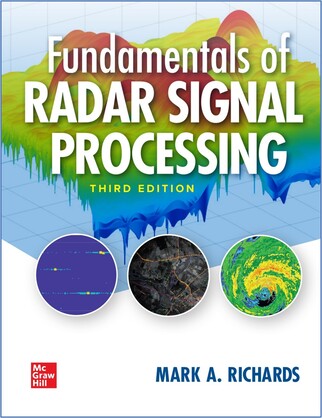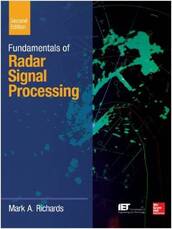Support Site for the textbook
Fundamentals of Radar Signal Processing,
(FRSP)
Mark A. Richards
McGraw-Hill, New York
Newly-Released Third Edition (2022)!
Supporting Resources:
Previous editions:
About the Book
Fundamentals of Radar Signal Processing (FRSP) provides in-depth coverage of fundamental topics in radar signal processing from a digital signal processing perspective. The techniques of linear systems, filtering, sampling, and Fourier analysis techniques and interpretations are used throughout to provide a modern and unified tutorial approach. The coverage includes a full range of the basic signal processing techniques upon which all radar systems rely, including such topics as target and interference models, matched filtering, waveform design, Doppler processing, parameter estimation, and threshold detection and CFAR. In addition, introductions are provided to the advanced topics of tracking, synthetic aperture imaging, and space-time adaptive array processing.
This book fills a void in the technical literature on radar. That literature offers a number of excellent books on radar systems in general. At the opposite end of the spectrum, a number of quality texts on advanced topics in radar signal processing such as synthetic aperture imaging, space-time adaptive processing, and MIMO radar have appeared in recent years. However, there is a substantial gap between the qualitative systems books and the advanced signal processing books. Since its first edition, FRSP has sought to bridge that gap by providing a concise, unified, and modern treatment of the basic radar signal processing techniques upon which these more advanced methods build.
New in the Third Edition
The third edition of FRSP has several new additions, reflecting the evolution of radar signal processing since the first and second editions in 2005 and 2014:
Fundamentals of Radar Signal Processing (FRSP) provides in-depth coverage of fundamental topics in radar signal processing from a digital signal processing perspective. The techniques of linear systems, filtering, sampling, and Fourier analysis techniques and interpretations are used throughout to provide a modern and unified tutorial approach. The coverage includes a full range of the basic signal processing techniques upon which all radar systems rely, including such topics as target and interference models, matched filtering, waveform design, Doppler processing, parameter estimation, and threshold detection and CFAR. In addition, introductions are provided to the advanced topics of tracking, synthetic aperture imaging, and space-time adaptive array processing.
This book fills a void in the technical literature on radar. That literature offers a number of excellent books on radar systems in general. At the opposite end of the spectrum, a number of quality texts on advanced topics in radar signal processing such as synthetic aperture imaging, space-time adaptive processing, and MIMO radar have appeared in recent years. However, there is a substantial gap between the qualitative systems books and the advanced signal processing books. Since its first edition, FRSP has sought to bridge that gap by providing a concise, unified, and modern treatment of the basic radar signal processing techniques upon which these more advanced methods build.
New in the Third Edition
The third edition of FRSP has several new additions, reflecting the evolution of radar signal processing since the first and second editions in 2005 and 2014:
- The most significant change is the explicit inclusion of continuous wave (CW) radar, reflecting the great expansion of these systems in automotive radar and other maturing applications. While general CW waveforms are discussed, FRSP focuses on the common "fast-chirp" frequency modulated CW (FMCW) variants and the commonality of their processing with that of pulsed radars at the CPI level and beyond..
- The ideas of virtual antenna elements and virtual arrays are introduced, laying the groundwork for understanding multiple-input, multiple-output (MIMO) radar concepts discussed in other texts.
- The keystone transform for mitigating range migration in Doppler processing is introduced.
- The hierarchy of synthetic aperture imaging algorithms is extended to include the range-migration algorithm. Also, a basic introduction to backprojection imaging is included.
- Along-track interferometry (ATI) is introduced to complement the displaced phase center antenna (DPCA) technique and provide a more complete introduction to ground moving target indication (GMTI) methods.
- Most chapters have added additional new homework problems.
About the Author
Mark A. Richards, Ph.D., is an educator and consultant with over 35 years of experience in radar signal processing practice and education, primarily (approximately 20 years) at the Georgia Tech Research Institute (GTRI) where he last served as Chief of the Radar Systems Division. His work there focused on topics such as millimeter wave target detection and classification, electronic warfare for imaging radars, airborne windshear detection, and embedded extreme-scale ISR applications. His time at GTRI was followed by 11 years of teaching and research in signal processing and high performance computing with Georgia Tech’s School of Electrical and Computer Engineering. Other previous positions included technical and program management staff at ESL, Lockheed-Georgia Company, and the U.S. Defense Advanced Research Projects Agency (DARPA).
Dr. Richards is a Fellow of the IEEE cited “for contributions to radar signal processing education”. He is the co-editor and author of multiple chapters of the text Principles of Modern Radar: Basic Principles and the sole author of the text Fundamentals of Radar Signal Processing. He developed and taught extensively for over 20 years in several professional education “short courses” in radar signal processing, synthetic aperture radar, and digital signal processing, in addition to teaching in numerous other radar-related courses.
More information is available at Dr. Richards' personal web page.
Mark A. Richards, Ph.D., is an educator and consultant with over 35 years of experience in radar signal processing practice and education, primarily (approximately 20 years) at the Georgia Tech Research Institute (GTRI) where he last served as Chief of the Radar Systems Division. His work there focused on topics such as millimeter wave target detection and classification, electronic warfare for imaging radars, airborne windshear detection, and embedded extreme-scale ISR applications. His time at GTRI was followed by 11 years of teaching and research in signal processing and high performance computing with Georgia Tech’s School of Electrical and Computer Engineering. Other previous positions included technical and program management staff at ESL, Lockheed-Georgia Company, and the U.S. Defense Advanced Research Projects Agency (DARPA).
Dr. Richards is a Fellow of the IEEE cited “for contributions to radar signal processing education”. He is the co-editor and author of multiple chapters of the text Principles of Modern Radar: Basic Principles and the sole author of the text Fundamentals of Radar Signal Processing. He developed and taught extensively for over 20 years in several professional education “short courses” in radar signal processing, synthetic aperture radar, and digital signal processing, in addition to teaching in numerous other radar-related courses.
More information is available at Dr. Richards' personal web page.
Fundamentals of Radar Signal Processing (FRSP) can be purchased at (among others)
Book Reviews
Recommended to accompany Fundamentals of Radar Signal Processing: the
Principles of Modern Radar (POMR) series
Principles of Modern Radar (POMR) series
|
Principles of Modern Radar: Basic Principles (POMR:BC) is the perfect “Radar 101” text. Ideal as both a text for newcomers and a reference for practitioners, it covers basic radar concepts and physics, subsystem technologies such as antennas and transmitters, and basic radar signal processing. It provides an excellent foundation for the “Radar 102” level of FRSP.
|
Principles of Modern Radar: Advanced Techniques (POMR:AT) builds on the foundation of POMR: Basic Principles and FRSP to explore advanced methods in waveforms, imaging, and adaptive processing; emerging techniques such as MIMO radar and compressive sensing, and a variety of special topics.
|
Principles of Modern Radar: Applications (POMR:APP) shows how the techniques of the first two POMR volumes and FRSP are put to use in real radars. Radar designs and performance are described for 16 different types of civilian and military radar systems, from simple police speed radars to advanced space-based surveillance systems.
|
All three volumes are available from Amazon, Barnes and Noble, and other retailers.






